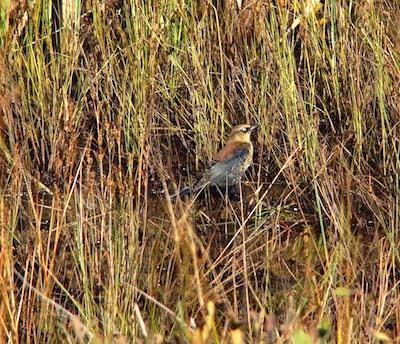
A Rusty blackbird/Vince Cavalieri
Last year, around this time, I made a plea for everyone to take part in the Rusty Blackbird Spring Migration Blitz. I’m back again with the same pitch in this, the third and final year of the blitz.
Not everyone loves blackbirds. We even have a nursery rhyme about baking two dozen of them into a pie, which seems uncalled for! But the birder who ignores this family is missing out on some fabulous birds. For one thing, some of the blackbirds are the true first signs of spring in the north.
Long before other songbirds return, the Red-winged, Brewer’s, Yellow-headed, and Rusty Blackbirds will be back, along with their cousins the grackles, cowbirds, and meadowlarks. The last members of the blackbird family (Icteridae) to get on the migration train are the orioles. They winter in southern Central America and South America, so the journey north is longer for them. The rest of the blackbirds winter in large numbers in the southern United States and northern Mexico.
Most of the blackbirds are doing just fine. Meadowlarks have adapted fairly well to agricultural land across the continent, with the song of the Western Meadowlark being a nearly constant soundtrack across much of the prairie. Red-winged Blackbirds stake out even the tiniest cattail marshes across the continent. A roadside ditch is enough of a wetland for those birds. Pull into the parking lot of your favorite grocery store in Texas and you’ll see somewhere between a dozen and 12,000 Great-tailed Grackles. They’ve adapted to urban life quite well.
The story is not the same for the Rusty Blackbird. They’re picky about the wetlands they use for nesting in northern Canada, and they seem somewhat particular about wintering grounds and migration stopovers as well. The global population has declined by about 95 percent since the 1960s. That’s the fast track toward extinction, and we’re not even sure why. Habitat loss and climate change are certainly partially involved, but the specifics elude us. It’s particularly important that we find what habitat the Rusties are using during the perilous spring migration.
That’s where the International Rusty Blackbird Working Group and their Spring Migration Blitz come in. With birders across the country entering Rusty sightings via the migration blitz protocol at eBird, a much clearer picture of Rusty Blackbird migration habits and habitat is developing.
One of the spots identified as a location of high interest after the first blitz was Congaree National Park, where some Rusty Blackbirds winter and others use as stopover. The Friends of Congaree Swamp redoubled their efforts to document the birds last spring and have been on the lookout this year as well. Most of the Rusties have headed north by now, but as of a few days ago, the Friends were still out looking for any stragglers. That’s the kind of grassroots citizen science we need to save imperiled birds!
Head out to a national park this spring and take a look at the blackbirds. You may find some Rusties down the trail in a cedar swamp or some grackles begging for food behind the visitors center. Either way, give them a good, long look. The common and underappreciated birds of today could become the critically endangered birds of the next generation.



Add comment